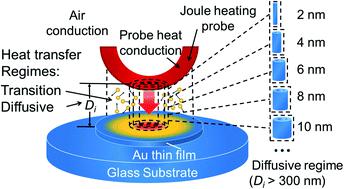当前位置:
X-MOL 学术
›
Nanoscale Adv.
›
论文详情
Our official English website, www.x-mol.net, welcomes your feedback! (Note: you will need to create a separate account there.)
Thermal conductivity measurements of thin films by non-contact scanning thermal microscopy under ambient conditions
Nanoscale Advances ( IF 4.7 ) Pub Date : 2020-12-14 , DOI: 10.1039/d0na00657b Yun Zhang 1 , Wenkai Zhu 1 , Theodorian Borca-Tasciuc 1
Nanoscale Advances ( IF 4.7 ) Pub Date : 2020-12-14 , DOI: 10.1039/d0na00657b Yun Zhang 1 , Wenkai Zhu 1 , Theodorian Borca-Tasciuc 1
Affiliation

|
Thermal conductivity measurements using Scanning Thermal Microscopy (SThM) usually involve heat transfer across the mechanical contact and liquid meniscus between the thermal probe and the sample. However, variations in contact conditions due to capillary effects at probe–sample contact and probe and sample wear due to mechanical contact interfere with accurate determination of the thermal conductivity. This paper presents measurements of thin film thermal conductivity using a SThM method employing a Wollaston probe in non-contact mode in synergy with detailed heat transfer analysis. In this technique, the thermal probe is scanned above the sample at a distance comparable with the mean free path of the ambient gas molecules. A Three-Dimensional Finite Element Model (3DFEM) that includes the specifics of the heat transfer between the sample and the probe in transition heat conduction regime was developed to predict the SThM probe thermal resistance and fit the thermal conductivity of the measured thin films. Proof-of-concept experimental in-plane thermal conductivity results for 240 nm and 46.6 nm Au films deposited on glass and silicon substrates were validated by experimental measurements of their electrical conductivity coupled with the Wiedemann–Franz law, with a discrepancy < 6.4%. Moreover, predictions based on a kinetic theory model for thin-film thermal conductivity agreed with the experimental results for the Au films with <6.6% discrepancy. To reduce the time and complexity of data analysis and facilitate experimental planning, an analytical model was also developed for the thermal transport between the Wollaston probe, ambient, and film-on-substrate samples. The accuracy of thin film thermal conductivity measurements using the analytical model was investigated using 3DFEM simulations. Fitted functions were developed for fast data analysis of thermal conductivity of thin films in the range of ∼100–600 W m−1 K−1 and thickness between ∼50–300 nm deposited on the two types of substrates investigated in this work, which yielded results with a discrepancy of 6–16.7% when compared to the Au films' thermal conductivity values.
中文翻译:

在环境条件下通过非接触式扫描热显微镜测量薄膜的热导率
使用扫描热显微镜 (SThM) 进行的热导率测量通常涉及热探头和样品之间的机械接触和液体弯月面的热传递。然而,由于探针-样品接触处的毛细效应以及由于机械接触导致的探针和样品磨损而导致的接触条件变化会干扰热导率的准确测定。本文介绍了使用 SThM 方法测量薄膜热导率,该方法采用非接触模式的 Wollaston 探针与详细的传热分析协同工作。在这种技术中,热探头在样品上方以与环境气体分子的平均自由程相当的距离进行扫描。开发了一个三维有限元模型 (3DFEM),其中包括在过渡热传导状态下样品和探针之间的热传递细节,以预测 SThM 探针热阻并拟合测量薄膜的热导率。沉积在玻璃和硅衬底上的 240 nm 和 46.6 nm Au 薄膜的概念验证实验面内热导率结果通过其电导率的实验测量以及 Wiedemann-Franz 定律进行验证,差异 < 6.4%。此外,基于薄膜热导率动力学理论模型的预测与金膜的实验结果一致,差异 <6.6%。为了减少数据分析的时间和复杂性并促进实验计划,还开发了一个分析模型,用于 Wollaston 探针、环境和基板上的薄膜样品之间的热传输。使用 3DFEM 模拟研究了使用分析模型的薄膜热导率测量的准确性。开发了拟合函数,用于对 100-600 W m 范围内薄膜的热导率进行快速数据分析-1 K -1和约50-300 nm 的厚度沉积在本工作研究的两种类型的基板上,与Au 薄膜的热导率值相比,产生的结果差异为6-16.7%。
更新日期:2021-01-04
中文翻译:

在环境条件下通过非接触式扫描热显微镜测量薄膜的热导率
使用扫描热显微镜 (SThM) 进行的热导率测量通常涉及热探头和样品之间的机械接触和液体弯月面的热传递。然而,由于探针-样品接触处的毛细效应以及由于机械接触导致的探针和样品磨损而导致的接触条件变化会干扰热导率的准确测定。本文介绍了使用 SThM 方法测量薄膜热导率,该方法采用非接触模式的 Wollaston 探针与详细的传热分析协同工作。在这种技术中,热探头在样品上方以与环境气体分子的平均自由程相当的距离进行扫描。开发了一个三维有限元模型 (3DFEM),其中包括在过渡热传导状态下样品和探针之间的热传递细节,以预测 SThM 探针热阻并拟合测量薄膜的热导率。沉积在玻璃和硅衬底上的 240 nm 和 46.6 nm Au 薄膜的概念验证实验面内热导率结果通过其电导率的实验测量以及 Wiedemann-Franz 定律进行验证,差异 < 6.4%。此外,基于薄膜热导率动力学理论模型的预测与金膜的实验结果一致,差异 <6.6%。为了减少数据分析的时间和复杂性并促进实验计划,还开发了一个分析模型,用于 Wollaston 探针、环境和基板上的薄膜样品之间的热传输。使用 3DFEM 模拟研究了使用分析模型的薄膜热导率测量的准确性。开发了拟合函数,用于对 100-600 W m 范围内薄膜的热导率进行快速数据分析-1 K -1和约50-300 nm 的厚度沉积在本工作研究的两种类型的基板上,与Au 薄膜的热导率值相比,产生的结果差异为6-16.7%。

























 京公网安备 11010802027423号
京公网安备 11010802027423号